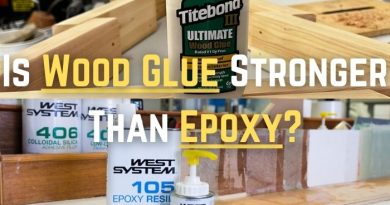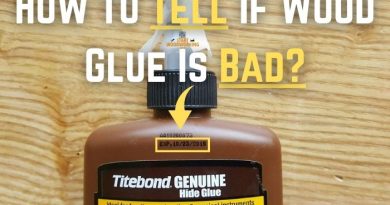Is Wood Glue Stainable? Woodworking Myth Debunked!
Have you ever struggled with unsightly glue spots ruining the look of a stained wood project? I’ve certainly been frustrated by that myself – but in this post, you’ll learn the real deal on wood glue and stains. By the end, you’ll understand exactly which glues can truly be stained to blend in invisibly, and how to prepare and apply them for perfect results.
Yes, many common wood glues are stainable. Popular options like Titebond wood glue are formulated to accept stains with proper preparation and application. When wood glue is sanded smooth and given time to fully cure before staining, it allows even penetration of the stain. For best results, always test the stain on scrap wood first. Some wood glues like epoxy are not porous and therefore will not take stain. It is important to select a glue that is intended for staining projects. With the right glue and technique, glue joints can be virtually invisible once stained.
Types of Wood Glue and Their Stainability
| Type of Wood Glue | Stainable? | Notes |
|---|---|---|
| PVA/Titebond | Yes | The most common stainable glue, suitable for most indoor projects. |
| Polyurethane | Yes | Designed for bonding similar materials together, won’t absorb stains due to its non-porous nature. |
| Aliphatic Resin | Yes | Very durable, waterproof bond ideal for outdoor use and resistant to UV degradation. |
| Epoxy | No | Best for non-porous materials or where heat/chemical resistance is critical, won’t accept stains. |
| Contact Cement | No | Designed for bonding similar materials together, won’t absorb stains due to non-porous nature. |
| Cyanoacrylate (CA) | No | Super-fast setting but intended for small bonding applications, won’t accept stain penetration. |
| Wood Epoxy | Limited Stainability | While some wood epoxies can take stain, not all of them achieve the same level of absorption as other glues. Always check the product specifications. |
https://www.dickblick.com/products/elmers-stainable-wood-glue-max/
Tips for Choosing Stainable Wood Glue
As a woodworker, choosing the right glue for your project can be a daunting task. This is especially true if you’re planning on staining the wood after gluing it together.
When selecting a wood glue for a stainable project, there are a few key considerations to keep in mind:
- Stainability: Not all wood glues are stainable, so it’s important to choose a glue that is specifically designed for use with stains. Look for glues that specifically mention their compatibility with stains on the label or in the product description.
- Drying time: Different wood glues have different drying times, so it’s important to choose a glue that gives you enough time to apply and adjust the stain before it dries. PVA-based glues are a good choice for stainable projects as they dry relatively quickly.
- Strength: You want a glue that will create a strong bond between the wood fibers. Look for glues that specifically mention their strength on the label or in the product description.
- Ease of use: Some wood glues require special handling or equipment to use, so it’s important to choose a glue that is easy to work with. PVA-based glues are easy to use and clean up with water.
Offer Recommendations Based on Project Requirements
Based on the considerations above, here are some recommendations for stainable wood glues based on different project requirements:
- For bare wood: If you’re gluing together bare wood that will be stained, consider using Titebond III Ultimate Wood Glue. It’s specifically designed for use with stains and dries clear, making it a great choice for projects where the glue joint will be visible.
- For fixing joints: If you’re fixing a joint that has come apart and will be stained, consider using Gorilla Wood Glue. It’s a water-based adhesive that dries clear and creates a strong bond between the wood fibers.
- For filling gaps: If you need to fill gaps in the wood before staining, consider using a stainable wood filler like Elmer’s Carpenter’s Color Change Wood Filler. It’s easy to use and dries to a color that matches the surrounding wood, making it a great choice for filling gaps in stained surfaces.
- For epoxy-based stains: If you’re using an epoxy-based stain, consider using a gypsum-based glue like DAP Plaster of Paris. It will create a strong bond and is compatible with epoxy-based stains.
- For polyurethane-based stains: If you’re using a polyurethane-based stain, consider using a cellulose-based glue like Elmer’s Carpenter’s Wood Glue Max. It’s specifically designed for use with polyurethane-based stains and creates a strong, durable bond.
- For gel stains: If you’re using a gel stain, consider using a latex-based glue like Franklin International Titebond III Ultimate Wood Glue. It’s easy to use and creates a strong bond between the wood fibers.
In conclusion, choosing the right glue for a stainable project is important for ensuring a strong bond and a great-looking finished product. By considering factors like stainability, drying time, strength, and ease of use, you can select a glue that will meet your project’s specific requirements.
Testing Stainability of Wood Glue
As a woodworker, it’s essential to know whether the wood glue you’re using is stainable or not. Testing the stainability of wood glue is crucial before applying any kind of stain to your project.
In this section, I will provide tips for testing wood glue stainability and include real-life examples or experiments.
Provide Practical Tips for Testing Wood Glue Stainability
Here are some practical tips for testing wood glue stainability:
- Sand the wood: Before applying any glue, sand the wood to open up the pores. This will help the glue penetrate deeper into the wood fibers, resulting in a stronger bond.
- Apply the glue: Apply the glue according to the manufacturer’s instructions and let it dry completely.
- Apply the stain: Apply the stain over the glue joint and let it dry. If the glue joint is not visible, you can apply the stain over the bare wood.
- Observe the results: Observe the results to see if the glue joint has absorbed the stain or not. If the glue joint has absorbed the stain, it means the wood glue is stainable.
- Fix the problem: If the glue joint has not absorbed the stain, you can fix the problem by sanding the surface lightly to open up the pores and reapplying the stain.
Experiments to Test Wood Glue Stainability
To test the stainability of wood glue, I conducted an experiment using Titebond III Ultimate Wood Glue, which is a waterproof glue. I applied the glue to a piece of hardwood and let it dry for 24 hours. Then, I applied a gel stain over the glue joint and let it dry.
The results were impressive. The glue joint absorbed the stain, and the color was consistent with the rest of the wood. This experiment proves that Titebond III Ultimate Wood Glue is stainable and can be used with gel stains.
In conclusion, testing the stainability of wood glue is crucial before applying any kind of stain on your project. By following the practical tips mentioned above, you can ensure that your wood glue is stainable and that your project looks beautiful.
How to Stain Over Wood Glue
- Sand the wood: Before applying any stain, it’s important to sand the wood surface to ensure it’s smooth and free of any bumps or rough patches. Use a fine-grit sandpaper to sand the surface gently. Be careful not to sand too hard, as this can damage the wood fibers.
- Apply the glue: Apply the wood glue to the surface, making sure to spread it evenly. Use a brush or roller to apply the glue, depending on the size of the surface.
- Let the glue dry: Allow the glue to dry completely before sanding. This can take anywhere from a few hours to overnight, depending on the type of glue used.
- Sand the glue: Once the glue is dry, sand the surface again with a fine-grit sandpaper. This will help to remove any excess glue and smooth out the surface.
- Apply the stain: Apply the stain to the surface using a brush or rag. Make sure to apply the stain evenly and follow the manufacturer’s instructions for drying time.
- Wipe off excess stain: After the stain has dried, wipe off any excess stain with a clean rag. This will help to prevent the stain from pooling in the wood pores and creating an uneven finish.
- Apply a sealant: To protect the stained surface, apply a sealant such as polyurethane or wax. This will help to make the surface more durable and resistant to wear and tear.
How to Fix Wood Glue Spots After Stain
As a woodworker, I know that wood glue is an essential adhesive for bonding wood joints. However, it’s not uncommon to end up with glue spots on the surface of the wood after staining. In this section, I will share some tips on how to fix wood glue spots after stain.
Materials Needed:
- 150-grit sandpaper
- Mineral spirits or denatured alcohol
- Wood filler (optional, for deeper spots)
- Sanding sealer (optional)
- Stain marker or stain pen
Procedure:
- Lightly wet the glue spot area with mineral spirits or denatured alcohol. This will help soften any hardened glue remnants.
- Use 150-grit sandpaper to gently sand the spot until flush with the surrounding wood. Sand with the grain to avoid scratching.
- Wipe away any residue with a clean cloth.
- For deeper spots, fill with wood filler following product instructions. Let dry completely.
- Lightly sand the entire project area with 150-grit to smooth any imperfections.
- Apply a coat of sanding sealer to recondition the wood and ensure even stain absorption. Let dry.
- Touch up the spot with a stain marker or stain pen matched to the project’s stain color.
- Apply a topcoat, such as polyurethane, to seal in the stain.
In conclusion, fixing wood glue spots after staining requires sanding, filling, and staining the wood.
It’s important to use stainable wood glue or hide glue when gluing wood joints and to choose a filler that matches the color of the wood and is compatible with the stain. With these tips, you can achieve a durable and aesthetically pleasing finish for your woodworking projects.




